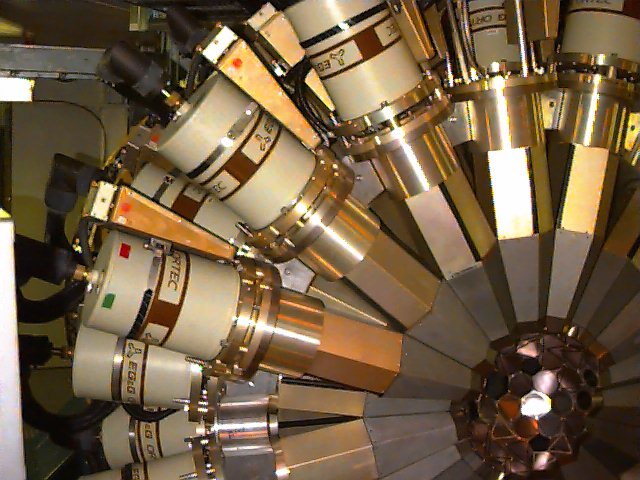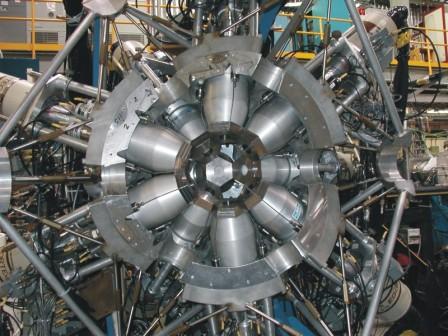Nuclear Spectroscopy Research
Our
nuclear spectroscopy research program involves accelerator-based experiments
carried out at a variety of facilities: Oak
Ridge National Laboratory, Lawrence Berkeley
National Laboratory, and TRIUMF.
In recent years, our spectroscopy experiments have used large arrays of
high-resolution Ge detectors, including Gammasphere,
an array of 110 detectors shown below left, and the 8-pi spectrometer, and
array of 20 detectors shown below right.


Our goals in these experiments have been to make high-resolution studies of the
gamma rays emitted in the radioactive decays of various nuclei in order to gain
a better understanding of their structure. In certain cases we have been
able to use the decay information to obtain astrophysical information, in
particular galactic lifetimes of nuclear species that are present in cosmic
rays. The spectroscopic information from the multi-detector arrays has
included data on the angular correlations of the gamma rays, which has enabled
us to deduce spin-parity assignments and the multipolarity
of the gamma transitions. Our collaborators in these experiments are
Professor John Wood of Georgia Tech and Professor Eric Norman of the University
of California at Berkeley. The research has been funded by the U.S.
Department of Energy.
Here are some representative
publications from these experiments (for a complete list click here):
"Cosmic-Ray History Derived from the 54Mn, 56Ni and 144Pm Chronometers," K. Zaerpoor, Y. D. Chan, D. E. DiGregorio, M. R. Dragowsky, M. M. Hindi, M. C. P. Isaac, K. S. Krane, R.-M. Larimer, A. O. Macchiavelli, R. W. Macleod, P. Miocinovic, E. B. Norman, and S. J. Robinson, Nucl. Phys. A654, 916c (1999).
“N = 90 Region: The Decay of 154Eu to 154Gd,” W. D. Kulp, J. L. Wood, K. S. Krane, J. Loats, P. Schmelzenbach, C. J. Stapels, R.-M. Larimer, and E. B. Norman, Phys. Rev. C 69, 064309 (2004).
“Identification of a Pairing Isomeric Band in 152Sm,” W. D. Kulp, J. L. Wood, P. E. Garrett, J. M. Allmond, D. Cline, A. B. Hayes, H. Hua, K. S. Krane, R.-M. Larimer, J. Loats, E. B. Norman, P. Schmelzenbach, C. J. Stapels, R. Teng, and C. Y. Wu, Phys. Rev. C 71, 041303 (2005).
“Precision
Test of the Rotor Model from Band Mixing in 166Er,” W. D. Kulp. J. M. Almond, P. Hatcher, J. L. Wood,
J. Loats,
P. Schmelzenbach,
C. J. Stapels,
K. S. Krane,
R.-M. Larimer,
and E. B. Norman, Phys. Rev. C. 73, 014308 (2006).
“N = 90 Region: The Decays of 152Eum,g
to 152Sm,” W. D. Kulp, J. L. Wood, J.
M. Allmond, J. Eimer, D.
Furse, K. S. Krane, J.
Loats, P. Schmelzenbach, C.
J. Stapels, R.-M. Larimer, E. B.
Norman, and A. Piechaczek, Phys. Rev, C 76, 034319
(2007).
Here is a list of
graduate theses of students who have worked in our group:
“A Study of the Decay 184Au
- 184Pt by Means of Gamma and Electron Spectroscopy and Low
Temperature Nuclear Orientation,” Yue-shu Xu (Ph.D.,
1992)
“Nuclear Structure Studies of 187,189Ir
Via Low Temperature Nuclear Orientation and
Coincidence Spectroscopy,” Mark A. Gummin (Ph.D.,
1992)
“Relative Lifetime
Measurements of 192Hg and 193Hg Superdeformed
Bands.” Brian C. Busse (Ph.D., 1997)
“54Mn, 56Ni, and
144Pm as Cosmic-Ray Chronometers,” Koorosh
Zaerpoor (Ph.D., 1998)
“Sudbury Neutrino Observatory Energy
Calibration Using Gamma-Ray Sources,” Michael R. Dragowsky
(Ph.D., 1999)
“The Study of 150Sm through
the Decay of 150Pm, 150mEu and 150gEu,” Paul
D. Schmelzenbach (Ph.D., 2003)
“Level Structure of 152Gd
Populated in 152Tb Beta Decay,” C. J. Stapels
(Ph.D., 2004)
“Angular Correlation Measurements From the Beta Decay of 166mHo and 166Tm
and the Properties of the Gamma Vibrational Band in 166Er,” Jeffrey
T. Loats (Ph. D., 2004)